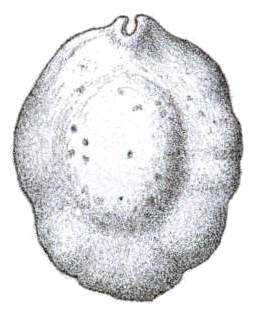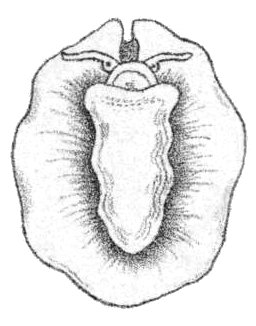|
Velutinidae
Velutinidae is a family of small sea snails, marine gastropod molluscs in the clade Littorinimorpha.Gofas, S. (2014). Velutinidae Gray, 1840. Accessed through: World Register of Marine Species at http://www.marinespecies.org/aphia.php?p=taxdetails&id=143 on 2014-10-14Philippe Bouchet, Rocroi J.P., Hausdorf B., Kaim A., Kano Y., Nützel A., Parkhaev P., Schrödl M. & Strong E.E. (2017). Revised classification, nomenclator and typification of gastropod and monoplacophoran families. Malacologia. 61(1-2): 1-526. The shell of these animals is very thin and delicate, and internal, completely covered by the mantle (which has fused lobes) so the appearance of these animals more closely resembles that of sea slugs rather than sea snails. Taxonomy The following two subfamilies were recognized in the taxonomy of Bouchet & Rocroi (2005): * Subfamily Velutininae J. E. Gray, 1840 - synonyms: Marseniidae Leach in Gray, 1847; Marsenininae Odhner, 1913; Capulacmaeinae Golikov & Gulbin ... [...More Info...] [...Related Items...] OR: [Wikipedia] [Google] [Baidu] |
Ciliatovelutina
''Ciliatovelutina'' is a genus of small sea snails, marine gastropod mollusks in the family Velutinidae. Species Species within the genus ''Ciliatovelutina'' include: * '' Ciliatovelutina capillata'' (Derjugin, 1950) * ''Ciliatovelutina lanata'' (Derjugin, 1950) * ''Ciliatovelutina lanigera'' (Møller, 1842) * ''Ciliatovelutina nana ''Ciliatovelutina'' is a genus of small sea snails, marine gastropod mollusks in the family Velutinidae. Species Species within the genus ''Ciliatovelutina'' include: * '' Ciliatovelutina capillata'' (Derjugin, 1950) * '' Ciliatovelutina lanat ...'' (Derjugin, 1950) References Velutinidae {{Velutinidae-stub ... [...More Info...] [...Related Items...] OR: [Wikipedia] [Google] [Baidu] |
Coriocella Nigra
''Coriocella nigra'' is a species of sea snail, a marine gastropod mollusk in the family Velutinidae. An Indo-Pacific species, it lives on rocks at depths of up to 15 m. It is up to 10 cm long and has an internal shell; body color is black or brown. ''C. nigra'' is probably a predator of tunicates. Taxonomy This species was described as ''Coriocella nigra'' by French zoologist Henri Marie Ducrotay de Blainville in 1824 and he placed it in the newly established genus ''Coriocella'' as its only species at that time. ''Coriocella nigra'' is the type species of the genus ''Coriocella''. Nowadays, at least six other species are recognized in the genus ''Coriocella'' and Blainville's binomial name is still treated as valid and in use. Distribution The distribution of ''Coriocella nigra'' is Indo-Pacific and includes South Africa, Mozambique, Kenya, [...More Info...] [...Related Items...] OR: [Wikipedia] [Google] [Baidu] |
Onchidiopsis Glacialis
''Onchidiopsis glacialis'' is a species of small sea snail with a transparent internal shell, a marine gastropod mollusk in the family Velutinidae. Because the shell is mostly internal, the snail resembles a sea slug in general appearance. Distribution The distribution of ''Onchidiopsis glacialis'' includes European waters. Description The maximum recorded (shell Shell may refer to: Architecture and design * Shell (structure), a thin structure ** Concrete shell, a thin shell of concrete, usually with no interior columns or exterior buttresses ** Thin-shell structure Science Biology * Seashell, a hard o ...?) length is 18 mm.Welch J. J. (2010). "The "Island Rule" and Deep-Sea Gastropods: Re-Examining the Evidence". '' PLoS ONE'' 5(1): e8776. . Habitat The minimum recorded depth for this species is 4 m; maximum recorded depth is 300 m. References Velutinidae Taxa named by Michael Sars Gastropods described in 1851 {{Velutinidae-stub ... [...More Info...] [...Related Items...] OR: [Wikipedia] [Google] [Baidu] |
Coriocella
''Coriocella'' is a genus of small slug-like sea snails, marine gastropod molluscs in the family Velutinidae.Bouchet, P. (2011). Coriocella Blainville, 1824. Accessed through: World Register of Marine Species at http://www.marinespecies.org/aphia.php?p=taxdetails&id=456342 on 2011-06-17 Description The ear-shaped shell is extremely thin, even membranous in part and concealed in the mantle. It has a small spiral turn at the apex. The aperture is very large. The shell lacks a columella. The soft body is elliptical and much depressed. The borders of the mantle are very thin, notched in front and spreading out widely. The oval foot is very small. The head is scarcely distinct. The two short and rather thick tentacles are contractile and concealed under the shield. The eyes are situated at the base of the tentacles. Species Species within the genus ''Coriocella'' include: *'' Coriocella fella'' Er. Marcus & Ev. Marcus, 1970 * '' Coriocella herberti'' Drivas & Jay, 1990 *'' Coriocel ... [...More Info...] [...Related Items...] OR: [Wikipedia] [Google] [Baidu] |
Coriocella Hibyae
''Coriocella hibyae'', common name the Hiby's coriocella or the velvet snail, is a species of sea snail, a marine gastropod mollusc in the family Velutinidae. Description Although it has a shell, the shell is hidden within folds of the mantle, and overall the creature looks more like a sea slug than a snail, but in situ its external appearance resembles that of a sponge, which makes it difficult to spot underwater. Hiby's coriocella is known from the Maldives, in the Indian Ocean The Indian Ocean is the third-largest of the world's five oceanic divisions, covering or ~19.8% of the water on Earth's surface. It is bounded by Asia to the north, Africa to the west and Australia to the east. To the south it is bounded by th .... Its distribution range may in fact be greater than this, but as yet little is known about this species. This species can reach a maximum size of 10 cm in length. It more closely resembles a sea slug than a sea snail, and there are five digit-lik ... [...More Info...] [...Related Items...] OR: [Wikipedia] [Google] [Baidu] |
Lamellaria Latens 2
''Lamellaria'' is a genus of small slug-like sea snails, marine gastropod molluscs in the family Velutinidae.Bouchet, P.; Gofas, S. (2012). Lamellaria. Accessed through: World Register of Marine Species at http://www.marinespecies.org/aphia.php?p=taxdetails&id=138101 on 2012-03-16 Species Species within the genus ''Lamellaria'' include: *'' Lamellaria ampla'' Strebel, 1906 * ''Lamellaria australis'' Basedow, 1905 * '' Lamellaria berghi'' ( Deshayes, 1863) * '' Lamellaria branca'' Simone, 2004 * '' Lamellaria capensis'' (Bergh, 1907) * ''Lamellaria cerebroides'' Hutton, 1883 * '' Lamellaria diegoensis'' Dall, 1885 - San Diego lamellaria * '' Lamellaria digueti'' Rochebrune, 1895 * '' Lamellaria elata'' Strebel, 1906 * † '' Lamellaria falunica'' de Morgan, 1920 * '' Lamellaria fernandinae'' Dall, 1927 * '' Lamellaria inflata'' (C.B. Adams, 1852) * '' Lamellaria kiiensis'' Habe, 1944 * '' Lamellaria koto'' Schwengel, 1944 * ''Lamellaria latens'' (Müller, 1776) * '' Lamellaria ... [...More Info...] [...Related Items...] OR: [Wikipedia] [Google] [Baidu] |
Lamellaria Latens
''Lamellaria latens'' is a species of small, slug-like sea snail, a marine gastropod mollusc in the family Velutinidae. It is native to the northeastern Atlantic Ocean and the Mediterranean Sea where it feeds on colonial ascidians Ascidiacea, commonly known as the ascidians, tunicates (in part), and sea squirts (in part), is a polyphyletic class in the subphylum Tunicata of sac-like marine invertebrate filter feeders. Ascidians are characterized by a tough outer "tun ... (sea squirts). Description The shell is not visible externally because it is completely covered by the mantle. The shell is thin, smooth and fragile, and consists of two whorls with an unobtrusive spire and a somewhat depressed profile. The largest whorl is equivalent to the total height of the shell. The aperture is extremely wide. There is no operculum and the maximum dimensions of the shell are . The part of the animal that is visible is the mantle, and this is smoother and less domed than the rat ... [...More Info...] [...Related Items...] OR: [Wikipedia] [Google] [Baidu] |
Lamellariinae
Lamellariinae is a subfamily of small slug-like sea snails, marine gastropod molluscs belonging to the family Velutinidae, in the order Littorinimorpha.MolluscaBase eds. (2022). MolluscaBase. Lamellariinae d'Orbigny, 1841. Accessed through: World Register of Marine Species at: https://www.marinespecies.org/aphia.php?p=taxdetails&id=224918 on 2022-05-26 Description Species with internal shell, hidden beneath a papillate mantle with lateral flaps. These flaps are in some genera fused to enclose the shell. The thin shell is smooth and contains two to three whorls of which the body whorl is rapidly expanding into a large aperture. Some species have a thick, hairy periostracum. They resemble dorid nudibranches, but differ by their smooth tentacles and the absence of a dorsal gill circlet. P.J. Hayward and J.S. Ryland - Handbook of the Marine Fauna of North-West Europe; Oxford University Press 1995; ISBN 0 19 854054 X Most species are carnivores feeding mainly on ascidians, tunicat ... [...More Info...] [...Related Items...] OR: [Wikipedia] [Google] [Baidu] |
Littorinimorpha
Littorinimorpha is a large order of snails, gastropods, consisting primarily of sea snails ( marine species), but also including some freshwater snails ( aquatic species) and land snails ( terrestrial species).Bouchet P. & Rocroi J.-P. (Ed.); Frýda J., Hausdorf B., Ponder W., Valdes A. & Warén A. 2005. ''Classification and nomenclator of gastropod families''. Malacologia: International Journal of Malacology, 47(1-2). ConchBooks: Hackenheim, Germany. . . 397 pp. http://www.vliz.be/Vmdcdata/imis2/ref.php?refid=78278 Previously, the Linnaean taxonomy used in the taxonomy of the Gastropoda by Ponder & Lindberg (1997) ranked like this: subclass Orthogastropoda, superorder Caenogastropoda, order Sorbeoconcha, suborder Hypsogastropoda, infraorder Littorinimorpha. The order Littorinimorpha contains many gastropoda families that were formerly placed in the order Mesogastropoda, as introduced by J. Thiele in his work from 1921. Evidence for this group being monophyletic is scanty. In ... [...More Info...] [...Related Items...] OR: [Wikipedia] [Google] [Baidu] |
Taxonomy Of The Gastropoda (Bouchet & Rocroi, 2005)
The taxonomy of the Gastropoda as it was revised in 2005 by Philippe Bouchet and Jean-Pierre Rocroi is a system for the scientific classification of gastropod mollusks. (Gastropods are a taxonomic class of animals which consists of snails and slugs of every kind, from the land, from freshwater, and from saltwater.) The paper setting out this taxonomy was published in the journal '' Malacologia''. The system encompasses both living and extinct groups, as well as some fossils whose classification as gastropods is uncertain. The Bouchet & Rocroi system was the first complete gastropod taxonomy that primarily employed the concept of clades, and was derived from research on molecular phylogenetics; in this context a clade is a "natural grouping" of organisms based upon a statistical cluster analysis. In contrast, most of the previous overall taxonomic schemes for gastropods relied on morphological features to classify these animals, and used taxon ranks such as order, superorder ... [...More Info...] [...Related Items...] OR: [Wikipedia] [Google] [Baidu] |
Clade
A clade (), also known as a monophyletic group or natural group, is a group of organisms that are monophyletic – that is, composed of a common ancestor and all its lineal descendants – on a phylogenetic tree. Rather than the English term, the equivalent Latin term ''cladus'' (plural ''cladi'') is often used in taxonomical literature. The common ancestor may be an individual, a population, or a species (extinct or extant). Clades are nested, one in another, as each branch in turn splits into smaller branches. These splits reflect evolutionary history as populations diverged and evolved independently. Clades are termed monophyletic (Greek: "one clan") groups. Over the last few decades, the cladistic approach has revolutionized biological classification and revealed surprising evolutionary relationships among organisms. Increasingly, taxonomists try to avoid naming taxa that are not clades; that is, taxa that are not monophyletic. Some of the relationships between org ... [...More Info...] [...Related Items...] OR: [Wikipedia] [Google] [Baidu] |



